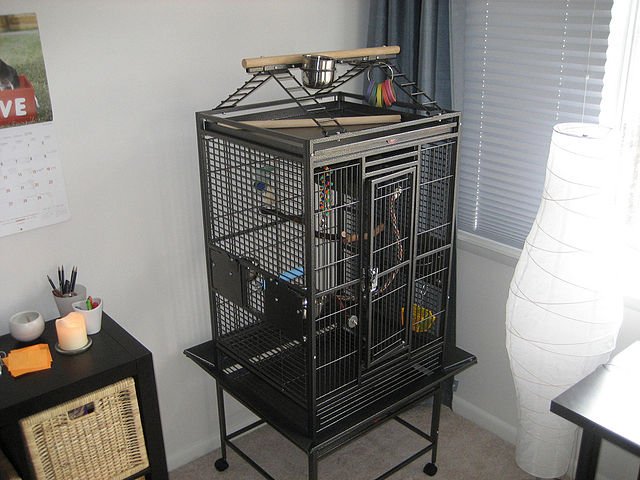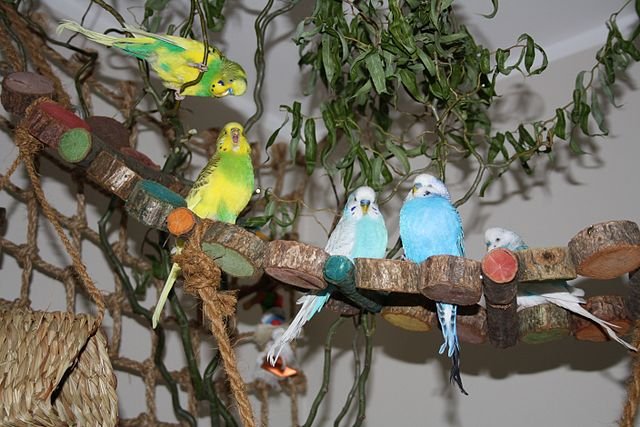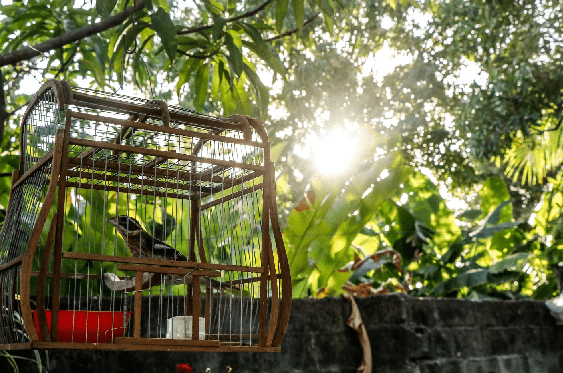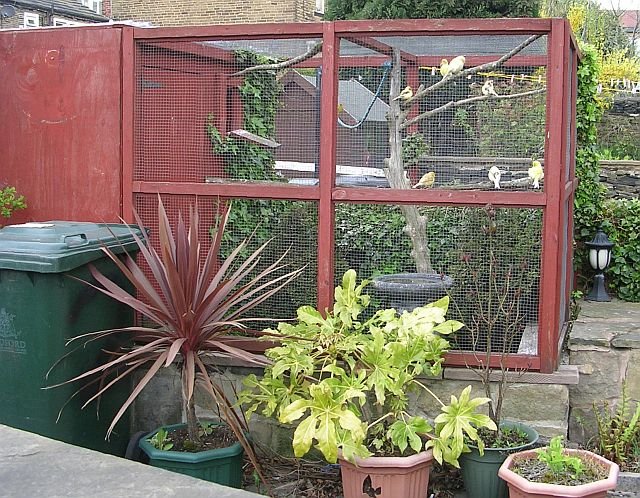Quaker parrots are very active and social creatures and love to take frequent flights. In the wild, the whole sky is their home, but when we add them to our families, they get restricted to our little homes. To fulfilling their flying needs, we need to take extra care while selecting a portion of our house where they are going to spend most of their time for the years to come.
Getting Quaker Parrot in new Cage
The way we set-up a cot for our newly born human babies, we also need to make some preparations for our little parrot babies. There is a need to set-up a cage for them, not to restrict them, but to prevent them from any dangers around our home. Once you have finished training your quaker parrot and have developed a bond with him, you can allow him to fly outside the cage while still under your supervision.
Quaker Parrot Cage Size
The first thing you should consider while setting-up a cage is its size. You shall bear in mind the flying needs of your pet along with the facilities you are going to provide him inside the cage. It is important to make a list of cage-sections you need to make for your baby’s various needs while determining the size of the cage.
Recommended Size of the cage is 26″x32″x34″, of course, bigger the cage is the better.
Position of cage

The other important aspect of setting-up the cage involves choosing the place where it should be kept inside your home. Some people prefer to keep their pet parrots in a very quiet room initially waiting for them to become familiar with humans first, but I would suggest against it. If you cut your new baby off of any human interaction, even from a distance, he is bound to take more time in getting comfortable with you and your other family members.
You shall consider placing his cage in a moderately busy room like a dining area, where he can learn that not all humans are predators. Carry out your daily activities normally without ever bothering him in the initial days, he’ll start getting comfortable with your presence around him. Gently take his cage with you while watching television shows to make him feel a part of your family.
Some precautions should be kept in mind while deciding upon the place of the cage. Your little baby is very sensitive to noise, so please do not place the cage in an area receiving loud noises, whether the noise is from television sets or your household appliances or the noise of a large gathering partying at your home. A piece of soft music, however, is loved by your parrot and he will quickly pick up the words of his favorite music.
Cage Design
The physical structure of the cage should be such as to ensure your quaker’s safety and provide him with sufficient security. The snap-shut doors are riskier for your pet as he might get hurt accidentally. Doors opening sideways are the most suitable choice.
Also, the locks must be working properly at all times as your parrot is very intelligent and might come out of the cage to fly freely. He can hurt himself in the process, so please don’t forget to check the door-locks every time you visit him.
Check for the bar spacing, it should be half an inch to prevent your parrot from squeezing into the bars and get his head hurt. Examine the material used in making the cage. Your curious parrot will nibble on its cage, so make sure the cage-material is completely non-toxic. Also, check for the use of any paint over the material to ensure that he does not swallow any toxins from these paints.
It is best to pick a cage made of stainless steel as it doesn’t require any paint coating and won’t even develop rust over time.
Cage Interior
The cage-structure can also be a source of entertainment for your Quaker parrot. Horizontal bars are a much better option than vertical ones as your little one loves to climb-up. If you can’t find a cage with horizontal bars, you can choose to set-up a ladder inside your little one’s home for his climbing needs.

Various high-low perches can also be kept at appropriate spaces in the cage. He will enjoy stepping up from one perch to another and it is an extremely beautiful sight for you to see. Ensure that all the material you provide to your parrot inside the cage is non-toxic as he will surely inspect everything with his beak.
Place a water container inside his cage and regularly fill it up with drinking water. You should also provide him with a food container inside for his daily food and nutrition requirements.
Fill it up at regular intervals of time and try to fix these timings as your pet parrot will expect the food around the same time every day. Clean these dishes daily to remove any dirt and dust and avoid contaminating the food with bacteria.
Fill your little baby’s home with toys to keep him entertained at all times. Swings, ropes, bells are a great source of physical activity for him. You can also add colorful toys for him to explore. Provide him with a mixture of various textures to enjoy scratching and rubbing over its surface.
Music is a favorite of all parrot species. Your quaker parrot also enjoys it to a great extent. Provide him with sound-producing toys and he will start amusing you by uttering a similar sound himself!
Quaker parrot nest
You also need to provide a roosting space to your parrot so that he can take proper rest and get a good amount of sleep regularly. It is essential for maintaining his physical as well as mental health. A simple small box can be used for creating this space or you can create a beautiful teepee for him to get into excitedly every time.

Ensure that there is an appropriate amount of darkness inside the roosting place for providing him with a sound sleep. Provide a dropping tray to your little parrot inside the cage so that he doesn’t poop anywhere and everywhere in his home.

Your bird’s cage is also a place to provide him proper training for carrying out his daily activities, to train him for a step-up and to make him aware of the dangers he might encounter in the outside world.
You should make his cage lively enough for him so that he is always ready to learn something new from you. Introduce him to educational toys from time to time for ensuring his proper mental growth.
Inculcate a habit of playing and exploring toys in him as it will help him enjoy the time with himself when you are away. Encourage good behavior in him by treating him on every good gesture shown by offering treats in the cage. This will help him maintain discipline inside the cage as he will repeat the behavior which helps him receiving rewards and treats.
Check our Amazon Store for good quality Cage for your bird.
Getting new bird friend for Quaker parrot
If you are planning to bring a new baby bird home, do not make the new bird share your quaker parrot’s cage in the initial days. They are complete strangers and might harm each other physically.
Get a different cage for your new baby and place it in the same room where your parrot’s cage is kept. Maintain a large distance between the cages initially, so that the birds can get comfortable seeing each other from a distance.
When you see a calmer behavior from both sides, you can consider reducing the distance between their cages, little at a time. With time, they will develop a bond of friendship and then you can introduce your new bird into your pet parrot’s cage if you desire.
Maintaining Cage
Maintaining proper hygienic conditions inside the cage is very important to protect your pet from developing any diseases. Regularly clean the surface of the cage as well as the cage accessories. Remove the used food and water containers on a daily basis.
Clean the poop-tray regularly for maintaining a healthy cage environment for him. Do not ever use any anti-bacterial soap to clean your pet baby’s surroundings as they are toxic for him. Replace the worn-out perches and toys with new ones. You can also provide your Quaker parrot a bathing session inside the cage for maintaining his hygiene and keeping him free from germs and pathogens.
Your little parrot’s cage is an important part of his life and he is going to stay there for the years to come. Try to make it as comfortable a place as it can be. Make him love his cage so much, by providing all his favorite stuff inside, that he never feels incomplete.
Spend sufficient time with him both indoors and outdoors to make him feel that the cage is not restricting him from anything. A cage should satisfy him to the extent that he doesn’t miss anything from the outside world.
Read about Quaker Parrot Diet:
https://parrotquaker.com/quaker-parrot-diet/



